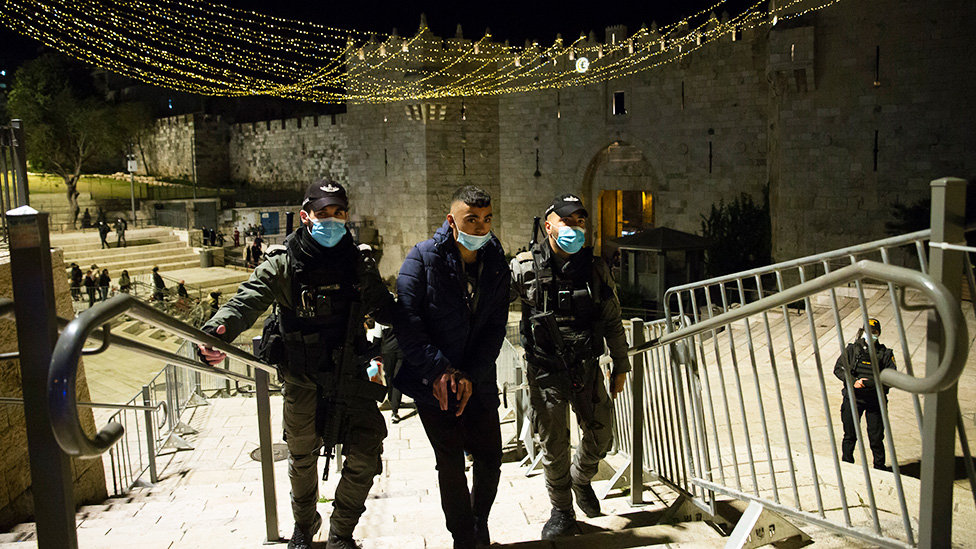
Israel conducted an intense aerial bombardment of the Gaza Strip hours after US president Joe Biden publicly backed international calls for a ceasefire between the Jewish state and Hamas, the Palestinian militant group.
Sixty Israeli warplanes carried out dozens of air strikes on what the military described as a network of tunnels, after Prime Minister Benjamin Netanyahu directed the armed forces to “continue striking”.
Hamas, the militant group that controls the Gaza Strip, retaliated with a volley of rockets into Israeli cities after a six-hour overnight lull. Witnesses reported that two buildings were targeted early on Tuesday in Gaza City, the heavily populated urban centre of the blockaded territory, as the fighting stretched into a second week.
Israeli strikes had killed 212 Palestinians, including 61 children and 36 women as of Monday, according to the Gaza health ministry.
Israeli army officials said 130 of the dead were Hamas combatants and disputed Gazan estimates that more than half of the dead were women and children. Israel has reported 10 dead from the Hamas attacks, including two children.
Biden spoke to Netanyahu as the US president faced rising criticism from American progressives, including within his own Democratic party, who want the administration to exert more pressure to stop the hostilities.
“The president expressed his support for a ceasefire and discussed US engagement with Egypt and other partners towards that end,” according to a White House readout of the call. Biden also “encouraged Israel to make every effort to ensure the protection of innocent civilians”.
The US blocked a UN Security Council statement calling for de-escalation, cessation of violence and respect for international law, according to two UN diplomats. The decision was the third time Washington has thwarted a statement or softer measures since the violence began.
The UN, Egypt and Qatar have failed to broker a short ceasefire to enable humanitarian aid to be sent into the Palestinian enclave, which has been controlled by Hamas since 2007.
Aviv Kochavi, Israel’s army chief, warned residents of communities adjoining the territory that the hostilities would continue as long as the country believed it was necessary.
“Hamas was surprised by our strength, method and achievements,” he said, referring to a military strategy, whereby Israel has carried out more air strikes at a faster pace than in earlier conflicts with Palestinian militants.
Israel has been condemned for targeting a building in Gaza that housed international media outlets over the weekend. Officials claimed that Hamas — which the US has designated a foreign terrorist organisation — operated from the same building.
Antony Blinken, US secretary of state, said Washington had asked for details justifying the decision to strike the building following the attack but he had not seen any evidence himself.
Dennis Ross, a former Middle East negotiator under both Democratic and Republican administrations, said the readout of the call between the Israeli and US leaders indicated that Biden was trying to bring the crisis to a close.
“It’s a subtle way of [Biden] making the point: ‘OK, you’ve done what you needed to do. Now it’s time to find a way out of this’,” he said.
Separately, several rockets were fired towards Israel from Lebanon on Monday, according to UNIFIL, the UN peacekeeping force on the Lebanon-Israel border. Lebanese state media reported that Israel retaliated with more than two dozen rockets. No casualties were reported in either incident.
The incident is the second rocket attack from Lebanon, which is home to thousands of Palestinian refugees, since the recent hostilities began between Israel and Hamas. No damage was inflicted on Israel.
Officials from Hizbollah, the Iran-backed paramilitary group in Lebanon which fought a month-long war with Israel in 2006, have broadly backed Palestinian militants. But the group has not signalled its intention to escalate the latest conflict.
https://news.google.com/__i/rss/rd/articles/CBMiP2h0dHBzOi8vd3d3LmZ0LmNvbS9jb250ZW50L2NkODM1MDFiLTdmYzUtNDA4Ny1hYzViLWQyMTMwMjhhZjU3YtIBP2h0dHBzOi8vYW1wLmZ0LmNvbS9jb250ZW50L2NkODM1MDFiLTdmYzUtNDA4Ny1hYzViLWQyMTMwMjhhZjU3Yg?oc=5
2021-05-18 06:47:10Z
52781577069323





















 Multiple notices seen at the redevelopment site along the Rajpath road in New Delhi [Money Sharma/AFP)]
Multiple notices seen at the redevelopment site along the Rajpath road in New Delhi [Money Sharma/AFP)] Mud dug out from Central Vista project being dumped near slums along the Yamuna river [Suchitra/Al Jazeera]
Mud dug out from Central Vista project being dumped near slums along the Yamuna river [Suchitra/Al Jazeera] Slum dwellers fear eviction as mud continued to be dumped near their shanties [Suchitra/Al Jazeera]
Slum dwellers fear eviction as mud continued to be dumped near their shanties [Suchitra/Al Jazeera]